- Clone
- 53-7.3 (See other available formats)
- Regulatory Status
- RUO
- Other Names
- Lyt-1, Ly-1, T1, Tp67, Ly-12
- Isotype
- Rat IgG2a, κ
- Ave. Rating
- Submit a Review
- Product Citations
- publications
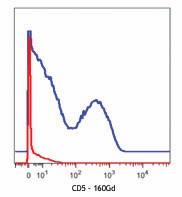
-

C57BL/6 mouse splenocytes (blue) and human Jurkat T cells (red) stained with 160Gd-anti-CD5 (53-7.3). Data provided by DVS Sciences.
| Cat # | Size | Price | Quantity Check Availability | Save | ||
|---|---|---|---|---|---|---|
| 100619 | 100 µg | 76€ | ||||
CD5 is a 67 kD protein, also known as Lyt-1, Ly-1, T1, Tp67, or Ly-12. It is a member of the scavenger receptor cysteine-rich protein superfamily (SRCR) and primarily expressed on thymocytes, T cells, and B-1 cells. Although mature α/β T cells express high levels of CD5, very few γ/δ T cells express this antigen. The interaction of CD5 with CD72, gp35-37, TCR, or BCR is involved in T and B cell activation.
Product DetailsProduct Details
- Verified Reactivity
- Mouse
- Antibody Type
- Monoclonal
- Host Species
- Rat
- Immunogen
- Mouse thymus or spleen
- Formulation
- Phosphate-buffered solution, pH 7.2, containing 0.09% sodium azide and EDTA.
- Preparation
- The antibody was purified by affinity chromatography.
- Concentration
- 1.0 mg/ml
- Storage & Handling
- The antibody solution should be stored undiluted between 2°C and 8°C.
- Application
-
FC - Quality tested
CyTOF® - Verified - Recommended Usage
-
This product is suitable for use with the Maxpar® Metal Labeling Kits. For metal labeling using Maxpar® Ready antibodies, proceed directly to the step to Partially Reduce the Antibody by adding 100 µl of Maxpar® Ready antibody to 100 µl of 4 mM TCEP-R in a 50 kDa filter and continue with the protocol. Always refer to the latest version of Maxpar® User Guide when conjugating Maxpar® Ready antibodies.
- Application Notes
-
Additional reported applications (for the relevant formats) include: immunoprecipitation1, and immunohistochemistry2 of acetone-fixed frozen tissue sections, zinc-fixed paraffin-embedded sections and formalin-fixed paraffin-embedded sections.
- Additional Product Notes
-
Maxpar® is a registered trademark of Standard BioTools Inc.
- Application References
-
- Ledbetter JA, et al. 1979. Immunol. Rev. 47:63. (IP)
- Ledbetter JA, et al. 1980. J. Exp. Med. 152:280. (FC, IHC)
- Bourdeau A, et al. 2007. Blood doi:10.1182/blood-2006-08-044370.
- RRID
-
AB_2562763 (BioLegend Cat. No. 100619)
Antigen Details
- Structure
- Member of the scavenger receptor cysteine-rich protein superfamily (SRCR), 67 kD
- Distribution
-
Thymocytes, T cells, B-1 cells
- Function
- Negative regulator of T-B cell interaction
- Ligand/Receptor
- CD72, gp35-37
- Cell Type
- B cells, T cells, Thymocytes
- Biology Area
- Costimulatory Molecules, Immunology
- Molecular Family
- CD Molecules
- Antigen References
-
1. Barclay A, et al. 1997. The Leukocyte Antigen FactsBook Academic Press.
2. Kipps TJ. 1988. Adv. Immunol. 47:117.
3. Antin JH, et al. 1985. J. Immunol. 136:505.
4. Tarakhovsky A, et al. 1995. Science 269:535. - Gene ID
- 12507 View all products for this Gene ID
- UniProt
- View information about CD5 on UniProt.org
Related FAQs
- Can I obtain CyTOF data related to your Maxpar® Ready antibody clones?
-
We do not test our antibodies by mass cytometry or on a CyTOF machine in-house. The data displayed on our website is provided by Fluidigm®. Please contact Fluidigm® directly for additional data and further details.
- Can I use Maxpar® Ready format clones for flow cytometry staining?
-
We have not tested the Maxpar® Ready antibodies formulated in solution containing EDTA for flow cytometry staining. While it is likely that this will work in majority of the situations, it is best to use the non-EDTA formulated version of the same clone for flow cytometry testing. The presence of EDTA in some situations might negatively affect staining.
- I am having difficulty observing a signal after conjugating a metal tag to your Maxpar® antibody. Please help troubleshoot.
-
We only supply the antibody and not test that in house. Please contact Fluidigm® directly for troubleshooting advice: http://techsupport.fluidigm.com/
- Is there a difference between buffer formulations related to Maxpar® Ready and purified format antibodies?
-
The Maxpar® Ready format antibody clones are formulated in Phosphate-buffered solution, pH 7.2, containing 0.09% sodium azide and EDTA. The regular purified format clones are formulated in solution that does not contain any EDTA. Both formulations are however without any extra carrier proteins.
Other Formats
View All CD5 Reagents Request Custom ConjugationCompare Data Across All Formats
This data display is provided for general comparisons between formats.
Your actual data may vary due to variations in samples, target cells, instruments and their settings, staining conditions, and other factors.
If you need assistance with selecting the best format contact our expert technical support team.
-
Biotin anti-mouse CD5

C57BL/6 mouse splenocytes stained with biotinylated 53-7.3, ... -
FITC anti-mouse CD5

C57BL/6 mouse splenocytes stained with 53-7.3 FITC -
PE anti-mouse CD5

C57BL/6 mouse splenocytes stained with 53-7.3 PE -
PE/Cyanine5 anti-mouse CD5
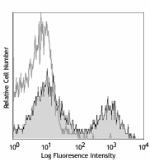
C57BL/6 mouse splenocytes stained with 53-7.3 PE/Cyanine5 -
Purified anti-mouse CD5
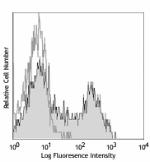
C57BL/6 mouse splenocytes stained with purified 53-7.3, foll... 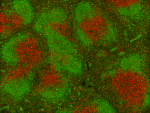
Fresh, frozen mouse spleen was stained with purified CD5 clo... -
Brilliant Violet 510™ anti-mouse CD5
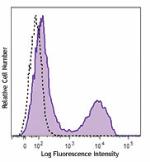
C57BL/6 mouse splenocytes were stained with CD5 (clone 53-7.... -
Alexa Fluor® 488 anti-mouse CD5
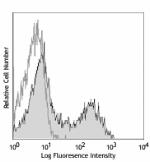
C57BL/6 mouse splenocytes stained with 53-7.3 Alexa Fluor® 4... -
Alexa Fluor® 647 anti-mouse CD5
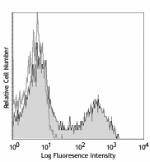
C57BL/6 mouse splenocytes stained with 53-7.3 Alexa Fluor® 6... -
PerCP anti-mouse CD5
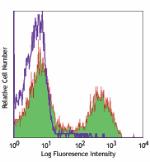
C57BL/6 mouse splenocytes stained with 53-7.3 PerCP -
Brilliant Violet 421™ anti-mouse CD5
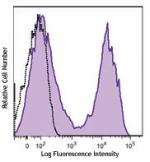
C57BL/6 mouse splenocytes were stained with CD5 (clone 53-7.... -
PE/Cyanine7 anti-mouse CD5
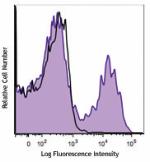
C57BL/6 mouse splenocytes were stained with CD5 (clone 53-7.... -
Purified anti-mouse CD5 (Maxpar® Ready)
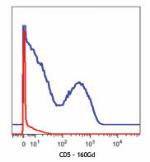
C57BL/6 mouse splenocytes (blue) and human Jurkat T cells (r... -
PerCP/Cyanine5.5 anti-mouse CD5
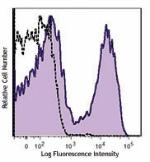
C57BL/6 mouse splenocytes were stained with CD5 (clone 53-7.... -
APC anti-mouse CD5

C57BL/6 mouse splenocytes were stained with CD5 (clone 53-7.... -
Alexa Fluor® 594 anti-mouse CD5
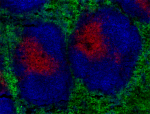
C57BL/6 mouse frozen spleen section was fixed with 4% parafo... -
APC/Fire™ 750 anti-mouse CD5
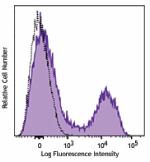
C57BL/6 mouse splenocytes were stained with CD5 (clone 53-7.... -
Alexa Fluor® 700 anti-mouse CD5
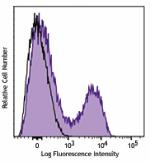
C57BL/6 mouse splenocytes were stained with CD5 (clone 53-7.... -
TotalSeq™-A0111 anti-mouse CD5
-
Brilliant Violet 711™ anti-mouse CD5

C57BL/6 mouse splenocytes were stained with CD3 FITC and CD5... -
Pacific Blue™ anti-mouse CD5

C57BL/6 mouse splenocytes were stained with CD3 FITC and CD5... -
PE/Dazzle™ 594 anti-mouse CD5

C57BL/6 splenocytes were stained with CD3 APC/Cyanine7 and C... -
TotalSeq™-B0111 anti-mouse CD5
-
TotalSeq™-C0111 anti-mouse CD5
-
APC/Cyanine7 anti-mouse CD5

C57BL/6 mouse splenocytes were stained with CD3 Alexa Fluor®... -
Brilliant Violet 605™ anti-mouse CD5

C57BL/6 mouse splenocytes were stained with anti-mouse CD3 F...
 Login / Register
Login / Register 













Follow Us